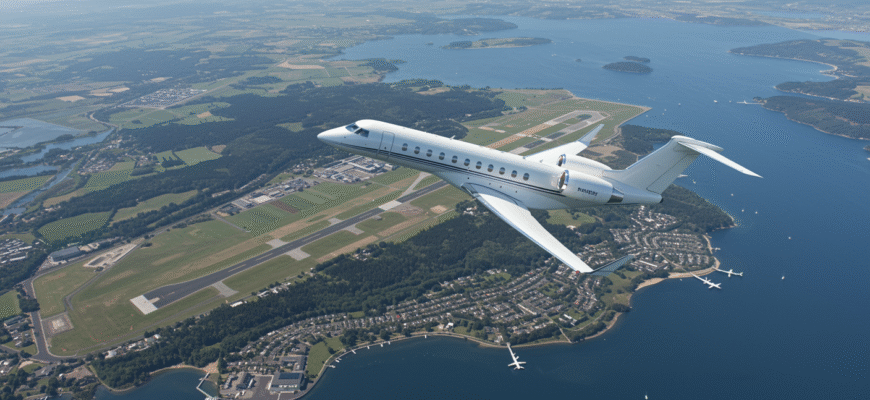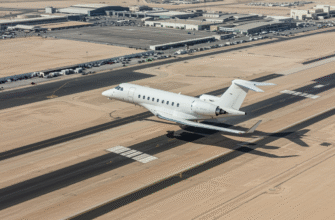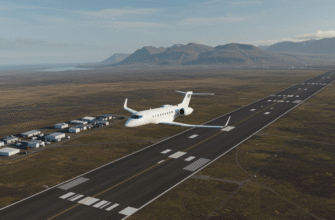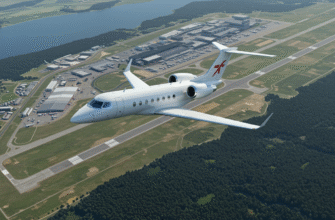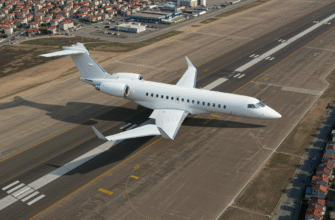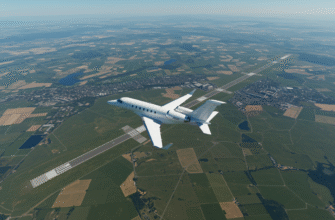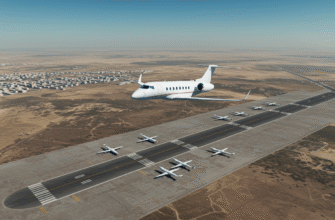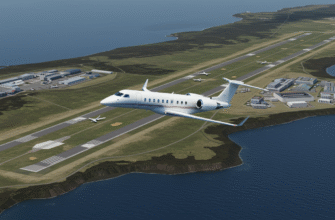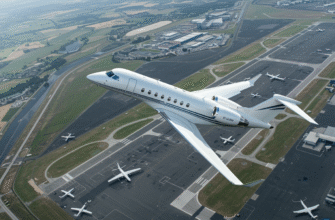Most people think of airports as either a pit stop on the way to somewhere better or a polished lounge dripping with overpriced lattes and travel Instagram filters. Aberdeen Airport doesn’t play by those rules. It’s not here to romance you with luxury. It’s here to move bodies, gear, and lives between land and sea. This place wakes up before the sun and never really goes to sleep — humming with the kind of energy that comes from 4 a.m. goodbye hugs and the pounding rhythm of rotor blades overhead. No one’s wearing vacation flip-flops here. You’re more likely to spot someone in high-vis dragging duffels streaked with grease than someone wheeling a designer carry-on.
ABZ is a core artery in Scotland’s industrial lifeline — the North Sea oil industry’s unofficial front door. Beneath its functional terminal walls is an unspoken ritual of people clocking in and clocking out of a life that’s equal parts isolation and bravery. This post is pulling back the airport curtain — getting real about who shows up here, why, and what the ground-level heartbeat of Aberdeen Airport actually sounds like. Spoiler: it’s not tropical music or comfy boarding calls. It’s survival gear. It’s families that know the clock better than the calendar. It’s cold air and even colder goodbyes.
The Unfiltered Identity Of ABZ
Aberdeen Airport isn’t built to charm you — it’s built to function. If you’re looking for glitz, this is the wrong terminal. ABZ stands at the crossroads of the North Sea industry and the people that keep it alive. The terminal carries the weight of steel-toe boots, toolbox wheels dragging across tile, and the distant churn of helicopters over the tarmac.
This isn’t a pitstop for beachgoers. It’s a dispatch zone for rig crews and offshore workers making their rotations. Real lives circle through these gates. Pregnant silences between crew check-ins. Workers checking messages from spouses before boarding. Talk about turbine repairs and broken weather radars, not gate upgrades and wine pairings.
It’s layered with fatigue, strength, and cold air that hits like unfinished sleep. Morning light filters through windows that catch more gray than gold. The vibe is work-hard clarity. No frills. Just movement. ABZ isn’t dressed to impress, it’s dressed to deploy. Honestly, that makes it more interesting than half the airports trying way too hard to look like luxury malls.
Who It’s Built For
- Oil rig crews shipping out before dawn
- Maintenance teams and offshore engineers
- Families pacing the arrivals hallway — waiting for a familiar face stepping off rotation
- Shift-change regulars — the ones who know which coffee stall opens first
The crowd at ABZ doesn’t window-shop. They line up for choppers. You see crews in jumpsuits and weather-beaten gear. Young parents sending partners away for three weeks at sea. Colleagues checking boarding times in silence. There’s a rhythm, a pattern, and a kind of wordless respect among those who pass through on repeat.
And then there are the families: the ones clenching tired toddlers at arrivals or sharing knowing glances during tea runs. They’re not meeting someone after a cheap holiday. They’re holding out for someone who’s been riding winter storms over the North Atlantic. At ABZ, the plane isn’t always the start of the trip — sometimes it’s just the middle.
The Rhythms And Routines
| Time | What’s Happening |
|---|---|
| 4:00 AM | Coffee shops open, rigs begin check-in, chopper crew rosters buzz |
| 5:30 AM | Taxis cycle through the drop-off lane, cold goodbyes hang in the wind |
| 7:15 AM | Mainline flights begin boarding — but most terminals still serve offshore cycles |
| Mid-morning to afternoon | Shift crews return, worn but wide-awake, searching for luggage and land |
The vibe at ABZ doesn’t shift by season — it runs on rotations. It knows the rhythm of two-weeks-on, two-weeks-off like muscle memory. People say goodbye here more than they say hello. And those goodbyes? They don’t look cinematic. They look heavy. Sometimes they’re silent. Sometimes they’re just a fifth cup of tea and a nod across the hallway.
Nothing runs on fluff. It’s early mornings, gear checks, security lines with boots that can’t be slipped off easily. Bags are packed with duty, not dreams. You’ll catch someone asleep on a bench at 10 a.m., mid-call with their kid, or chugging a lukewarm sandwich before heading offshore. The routines aren’t cushioned by comfort, but they’re solid — like scaffolding made out of missed birthdays and planned paydays.
A Brief History Of Aberdeen Airport
Aberdeen Airport didn’t start out as Scotland’s oil gateway — it actually launched in the 1930s as part of Eric Gandar Dower’s dream to pioneer air travel with Aberdeen Airways. That dream quickly got rerouted during WWII when the Royal Air Force took over and transformed the space into RAF Dyce. Wartime needs stamped a utility-first mindset into the area, and decades later, that legacy still defines the airport’s day-to-day personality.
Civil aviation crept in after the war, but the airport really carved out its identity during the 1970s when the discovery of North Sea oil threw Aberdeen into a new kind of orbit. Helicopters became lifelines. Offshore connections ruled the schedule. ABZ had no choice but to evolve — from a regional airstrip to the go-to launchpad for energy workers headed straight into one of the planet’s most volatile marine work zones.
Even now, remnants of that transformation are scattered throughout the grounds. From rotor marks scarring the landing pads to survival gear drying in side hallways — it’s clear the airport aged alongside the rise of the rigs.
What To Expect (And Not Expect) At ABZ
Those looking for spa lounges or sleek quiet zones should brace for disappointment. ABZ doesn’t dazzle. It’s built like part of a worksite — with practical tiles, long benches, and hallways more useful than pretty. You’re not here for relaxation. You’re here to get somewhere hard to reach.
But there are a few silver linings:
- If you’re up before sunrise, the coffee isn’t bad — strong enough to cut through jet lag or dawn fog
- The check-in desk crew are quick and kinder than expected
- Charging stations everywhere and enough benches to crash between connections
Suitcases here are often industrial duffels with the logo of an energy company stamped on top. The footwear of choice? Boots — scuffed, steel-toed, and built for ice. This is gear-before-glamour territory.
And don’t waste your time looking for:
- Instagrammable plant walls
- Trendy skincare boutiques
- Lounges selling cucumber water and hermetically sealed cucumber sandwiches
Here, it’s not about the airport experience. It’s about getting to the next job, getting home, or getting through. Priority boarding means nothing if your chopper’s already fueling behind Terminal 4. The real lane here? It’s the one lined with people carrying both weight and purpose.
The Helicopter Culture
Ever wonder why some airports feel more like military outposts than tourist traps? At Aberdeen Airport, it’s not uncommon to hear a chopper take off before the terminal lights flicker on. This isn’t Heathrow. It’s rotor blade city.
Oil dictates the rhythm here. Offshore transport rules the skies. CHC, Babcock, and Bristow aren’t just names—they’re lifelines to the North Sea. These companies rotate in shifts so constant you could set your watch to them.
Helicopters outpace fixed-wing planes by a mile. The heliport stays louder, busier, sweatier than the main runway. Some weeks, you’ll see more chopper tail rotors than check-in tags.
Being under a low-flying bird here isn’t rare—it’s normal. Between the rotor wash and the biting cold, stepping onto the tarmac feels less like travel and more like deployment. Check-ins run like clockwork because they have to. No one misses a chopper without causing chain-reaction chaos back out on the rigs.
Standard travel gear? Forget flip-flops. These passengers wear pressure suits, thick boots, and survival helmets. Every outbound trip starts with a training video nobody’s watching—their minds are already a hundred miles offshore.
What keeps them coming back? Routine and rhythm: two-on, two-off. That work cycle is everything. When a chopper lands at ABZ with a batch of oil workers, you can almost feel the city breathe out. Each arrival is someone’s finish line. Each departure, someone else’s starting block.
Working-Class Grit in a Global Industry
You can spot an oil worker a mile off. Not just for the hi-vis jackets and boots—dark eyes, cracked knuckles, shoulders held like they’re always bracing for wind.
Sit near the gate and you’ll hear pieces of their lives break through the hum of espresso machines: a near-miss on the platform, a boss who demanded too much, a kid’s birthday missed again. Some of it’s laughing noise, soaked in sarcasm. Some of it’s quiet, tired truth with an edge of smoke from a pre-flight cigarette.
Here, function trumps everything. Kit bags patched with duct tape. Mixed brands of thermal gear. Nothing matches, but it all matters.
- Hi-vis vests and duct-taped duffle bags.
- Steel-toed boots worn down to stories.
- Pocket notebooks with scribbled numbers, just in case the radios fail again.
No one’s dressing for comfort—no one’s performing. It’s workwear, full stop. Style doesn’t stand a chance when you’re facing gale-force winds in the middle of the sea.
And through it all? A kind of quiet steel, not for show. This isn’t a tough-guy act. It’s just survival rewrapped in schedule. You go out, you do what’s needed, you come home. No drama—just another day dodging freezing spray and costly mistakes.
Broomfield House: The Soul of ABZ
If the airport has a heart, it’s not the glossy terminal. It’s not even the control tower. It’s Broomfield House—half logistical machine, half time capsule.
It’s not pretty. Linoleum floors. Offices that smell like paper and industrial socks. But inside is where the invisible machinery works hardest—routing rotas, checking manifests, tracking flights bound for rigs most people don’t know exist.
Most travelers won’t notice it. No signs point the way. But for thousands of offshore workers, this small, scrappy corner of ABZ is the nerve center.
It’s where week-on, week-off lives rotate through invisible transitions. Some leave worn out. Others arrive aching to get back to sea. Broomfield House keeps the rhythm. No fuss, just flow. Every departure cleared through here echoes far beyond the runway.
